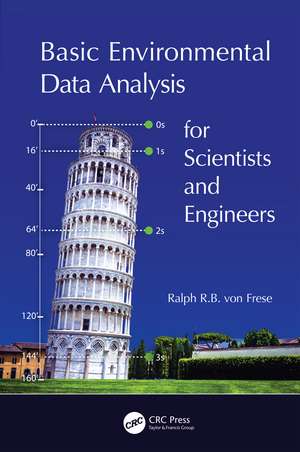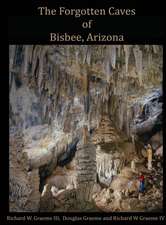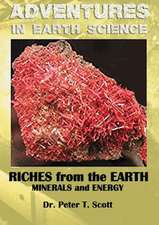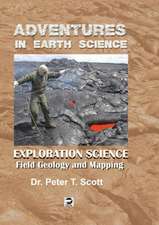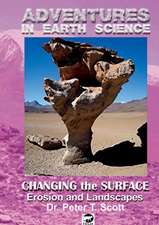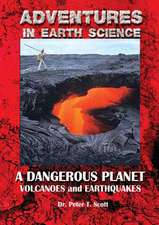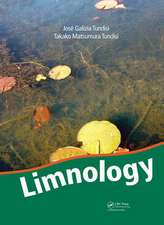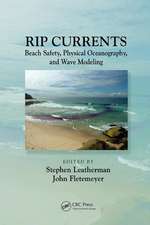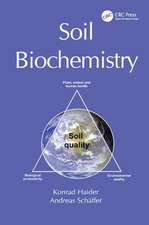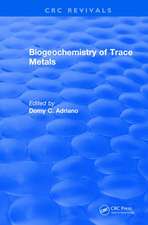Basic Environmental Data Analysis for Scientists and Engineers
Autor Ralph R.B. Von Freseen Limba Engleză Hardback – 27 noi 2019
Basic Environmental Data Analysis for Scientists and Engineers introduces practical concepts of modern digital data analysis and graphics, including numerical/graphical calculus, measurement units and dimensional analysis, error propagation and statistics, and least squares data modeling. It emphasizes array-based or matrix inversion and spectral analysis using the fast Fourier transform (FFT) that dominates modern data analysis. Divided into two parts, this comprehensive hands-on textbook is excellent for exploring data analysis principles and practice using MATLAB®, Mathematica, Mathcad, and other modern equation solving software.
Part I, for beginning undergraduate students, introduces the basic approaches for quantifying data variations in terms of environmental parameters. These approaches emphasize uses of the data array or matrix, which is the fundamental data and mathematical processing format of modern electronic computing. Part II, for advanced undergraduate and beginning graduate students, extends the inverse problem to least squares solutions involving more than two unknowns.
Features:
- Offers a uniquely practical guide for making students proficient in modern electronic data analysis and graphics
- Includes topics that are not explained in any existing textbook on environmental data analysis
- Data analysis topics are very well organized into a two-semester course that meets general education curriculum requirements in science and engineering
- Facilitates learning by beginning each chapter with an ‘Overview’ section highlighting the topics covered, and ending it with a ‘Key Concepts’ section summarizing the main technical details that the reader should have acquired
- Indexes many numerical examples for ready access in the classroom or other venues serviced by electronic equation solvers like MATLAB®, Mathematica, Mathcad, etc.
- Offers supplemental exercises and materials to enhance understanding the principles and practice of modern data analysis
| Toate formatele și edițiile | Preț | Express |
|---|---|---|
| Paperback (1) | 298.77 lei 6-8 săpt. | |
| CRC Press – 21 ian 2023 | 298.77 lei 6-8 săpt. | |
| Hardback (1) | 626.99 lei 6-8 săpt. | |
| CRC Press – 27 noi 2019 | 626.99 lei 6-8 săpt. |
Preț: 626.99 lei
Preț vechi: 840.15 lei
-25% Nou
Puncte Express: 940
Preț estimativ în valută:
119.99€ • 123.96$ • 99.86£
119.99€ • 123.96$ • 99.86£
Carte tipărită la comandă
Livrare economică 25 martie-08 aprilie
Preluare comenzi: 021 569.72.76
Specificații
ISBN-13: 9781138627789
ISBN-10: 113862778X
Pagini: 298
Ilustrații: 109
Dimensiuni: 156 x 234 x 19 mm
Greutate: 0.56 kg
Ediția:1
Editura: CRC Press
Colecția CRC Press
ISBN-10: 113862778X
Pagini: 298
Ilustrații: 109
Dimensiuni: 156 x 234 x 19 mm
Greutate: 0.56 kg
Ediția:1
Editura: CRC Press
Colecția CRC Press
Cuprins
Preface. Computing Trends. Data Attributes. Error Analysis. Statistics. Data Sampling. Algebraic Linear Regression. Matrix Linear Regression. Basic Digital Data Analysis. Array Methods. Spectral Analysis. Data Interrogation. Data Graphics. References. Index.
Descriere
This hands-on textbook introduces basic concepts of modern digital data analysis and graphics including numerical/graphical calculus, measurement units and dimensional analysis, non-statistical and statistical error analysis, etc.
Notă biografică
Ralph R.B. von Frese is Professor of Earth Sciences at The Ohio State University, where he has taught undergraduate and graduate courses in geomathematics, geophysics, and environmental and earth sciences since 1982. His research has focused mostly on archaeological and planetary applications of gravity and magnetic fields, and he has authored or co-authored an exploration geophysics textbook and more than 125 journal publications including 3 special journal volumes, and served on several government and scientific panels. He is a founding co- chair of the Antarctic Digital Magnetic Anomaly Project (ADMAP), an international collaboration of the Scientific Committee for Antarctic Research (SCAR) and the International Association of Geomagnetism and Aeronomy (IAGA). He is a member of the Society of Exploration Geophysicists, the American Geophysical Union, and the Geological Society of America.
